- Home
- Woven Picots
Woven picots make wonderful
embroidered leaves
Have you tried woven picots yet? I think they are the unsung heros of dimensional embroidery.
Whether you're adding delicate leaves, colourful petals or whimsical details like bunny ears, this versatile stitch has many creative possibilities.
I’ve used woven picots in many of my own designs, including the leaves in front of a stumpwork bunny’s basket, sepals on a strawberry, and even sunflower petals.
In this step-by-step woven picot stitch tutorial, I've used Pearl cotton number 8 to demonstrate the stitch so that you can see what I am doing in the photographs. For a more delicate effect, I typically use a thinner thread such as tatting cotton.
Feel free to practice with the Pearl cotton to get a feel for the process before experimenting with finer threads.
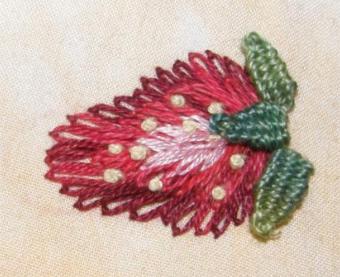
This sample is part of a crazy quilt block, but you can use any embroidery fabric. I've used firm linen cloth in the example above. The woven picot leaves add dimension to the lazy daisy stitch strawberry.
Step-by-Step Guide to Woven Picots
(Perfect for beginners and advanced stitchers alike).
Materials you'll need
- Pearl cotton, embroidery floss or tatting thread
- Needle
- Embroidery hoop
- Fabric of choice
- Patience and a touch of creativity!
Step 1: Set the foundation
Thread two needles. Your first needle should hold your working thread. You can use any leftover thread in the second needle, as it is for temporary use only.
Begin with the second needle and create a short vertical stitch, as illustrated. This sets the foundation for your woven picot. Secure the stitch by knotting the ends together at the back of the work; it will be removed once the leaf is complete.
Now take your needle that holds the working thread. Bring it up through the fabric at the base of your leaf. The distance between the first stitch and this point will set the length of your picot.
Slip the needle through the temporary stitch, without going through the fabric. Then take it to the back at the base, to the side of where the needle came up. Bring it back to the front in between those two base points.
Slip the needle once more through the temporary stitch to form a triangle shape with a centre line, as shown in the photo below. The needle is shown in position to start weaving.
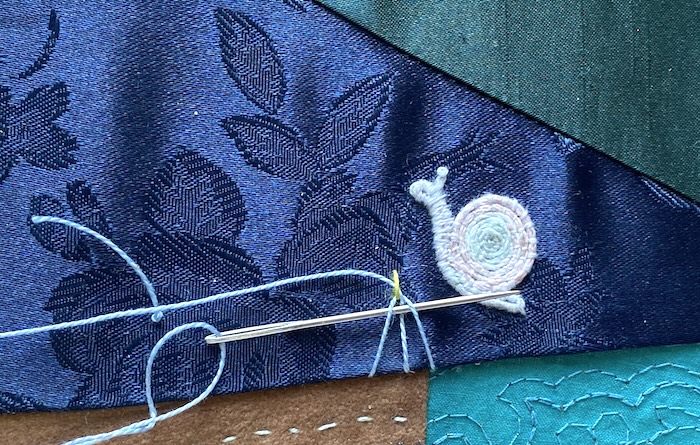
Step 2: Begin weaving
Weave the needle under two threads in one direction and under one thread in the other, taking care not to pierce the fabric.
To create a solid foundation for your leaf, keep your initial stitches tight. After a few stitches, use your needle to gently push the weaving towards the tip, eliminating any gaps.
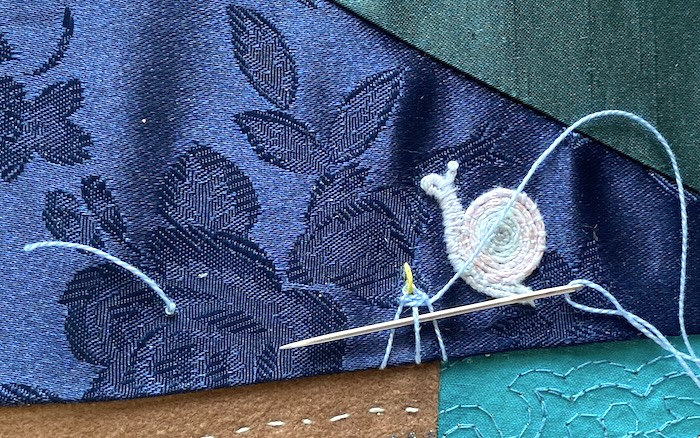
Step 3: Shape your leaf
Continue to weave back and forwards, working down to the base of the leaf.
As you approach the middle, ease the tension to allow the leaf to widen. Continue to place stitches close together, creating a firm picot.
Although the weaving is simple, achieving the right tension requires some practice. It's a good idea to practice on a scrap of fabric first to master the tension before adding woven picots to your project.
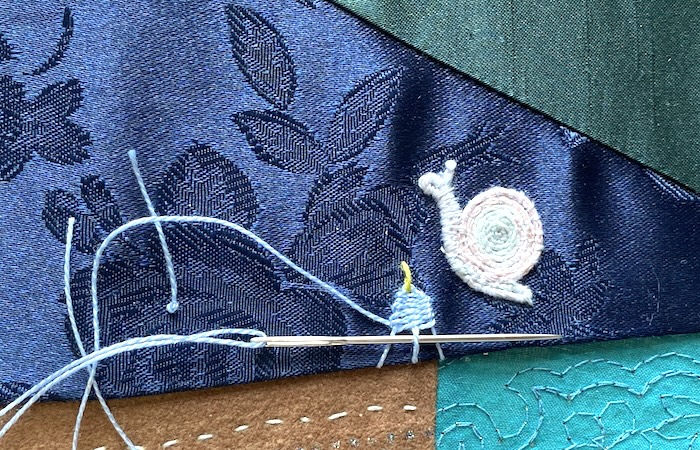
Step 4: Complete your leaf
As you approach the base of your picot, increase the tension to maintain a well-shaped leaf.
Continue working until you can no longer add rows of weaving to the picot. Then, take the needle to the back and secure it.
If other stitching is present, pass the needle under it to fasten off. If not, "park" the needle by bringing it to the surface at the edge of your work, where you can secure it later.
Snip the scrap thread at the tip of your picot and remove it to set your stitching free!
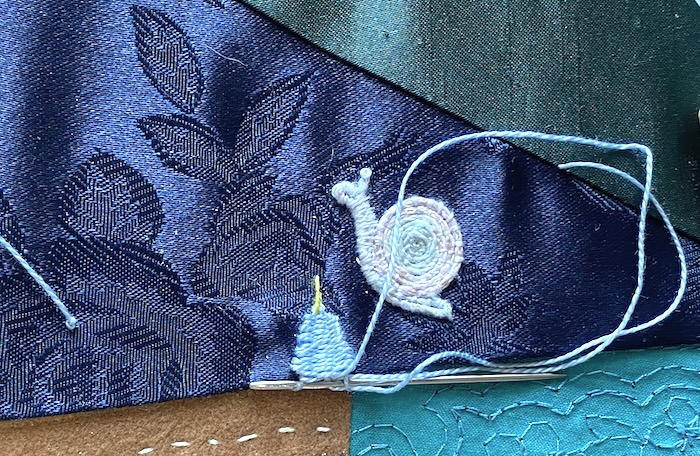
Extra tip
In the photo, I'm working on a third woven picot, which partly conceals the couched snail. To avoid catching the snail's threads, I weave the needle through the leaf shape further down, then slide it up into position before tensioning.
To prevent twisting, longer picots can be secured with a small stitch in the same colour, holding them in place after the holding stitch is removed.
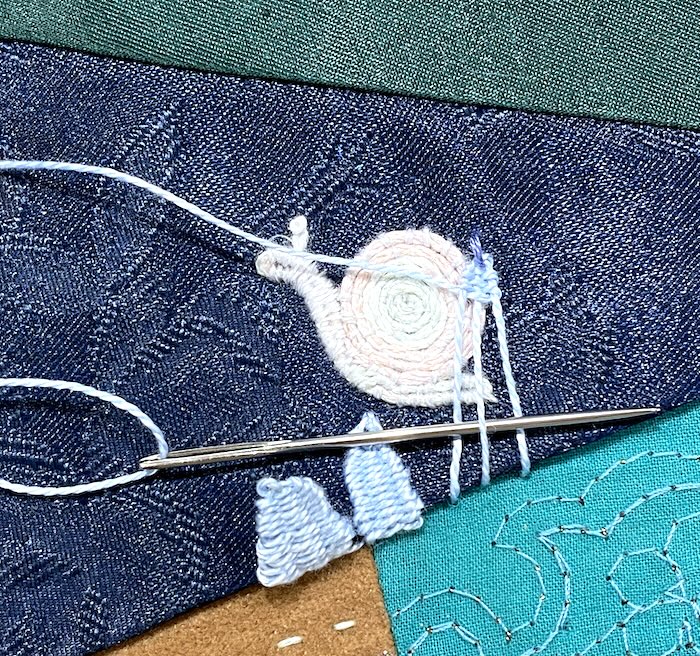
The photo below shows the longer leaf completed. This one I left loose so you can move it to one side to see the snail, adding that 3D element.
You could create a whole garden full of leaves in this manner.
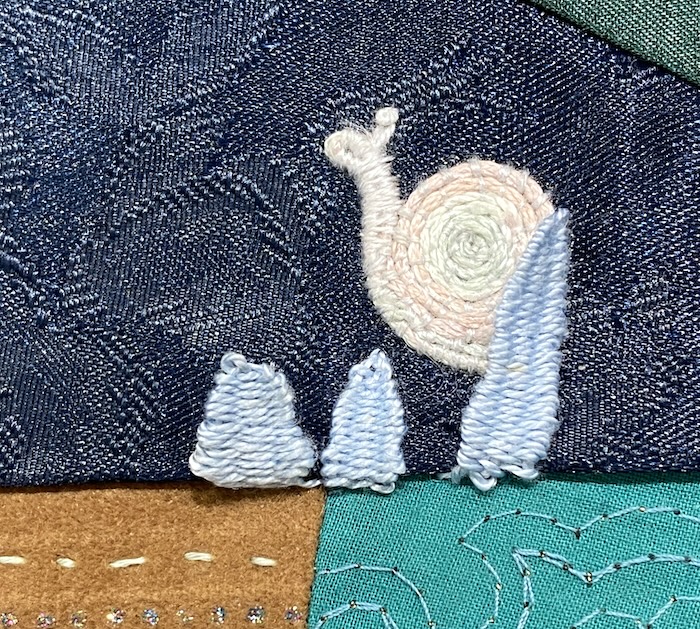
Creative Applications for Woven Picots
Leaves in Stumpwork Designs**: As in my bunny project, woven picots make lifelike leaves. Try using tatting thread for fine details or experiment with variegated threads for a natural look.
Petals and Flowers: Create dimensional roses, daisies, or fantasy blossoms by adjusting the length of your picots. If you make really long ones, you can roll them up and then secure them in place to create circular flowers that stand proud of your work.
Animal Details: Soft bunny ears, fluttering butterfly wings, or even a dragonfly’s delicate form can be brought to life with woven picots. Just adjust your tension to shape the overall effect.
** For other options check out my how to embroider a leaf page.
Troubleshooting Tips
Uneven Weaving: If your stitches look wonky, double-check that the loop is held taut and your needle is weaving consistently over and under.
Maintaining Tension: Tension is key to keeping the edges of your picot neat and firm. Ensure your thread is snug as you weave—too loose, and your picot may look floppy; too tight, and it might distort the loop.
Longer Picots Collapsing: For larger designs, consider reinforcing the loop with a fine wire or carefully stiffening the thread with fabric glue on the back (applied sparingly).
Affiliate links
Here's what I recommend to work woven picots:
Threads: Fil à Dentelles 80 for delicate picots, or DMC embroidery floss
Needles: Milliner's Needles or Sashiko Needles for weaving
Hoops: Adjustable embroidery hoop for consistent fabric tension
Affiliate links help support this site at no additional cost to you. Thank you for your support!
Stay connected between projects
If you’d like occasional updates from my embroidery room, including new patterns, gentle tips, and little things I think you might enjoy, you’re warmly invited to join the Stitchin’ Times newsletter.
No pressure. Just a friendly note now and then to keep you inspired.



